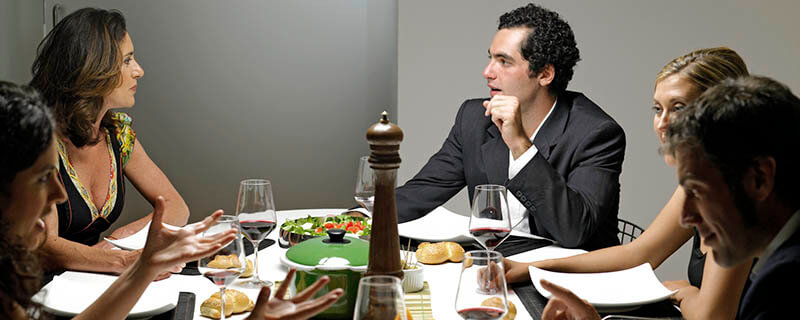
Dinner Party Etiquette
essentials
- A well planned menu.
- A table with ironed linen, polished silver, and sparkling glassware.
- Well prepared food.
- A welcoming host.
plan ahead
Serve something you've served before.
Have a simple to prepare fallback if something goes wrong with a dish or course.
informal dinner party
the menu
Consider the season.
Light foods, such as main-course salads and cold soups, are good choices in the summer.
Heavy foods, such as stews and roasts, in winter.
Make use of the season in another way by creating a menu using fresh seasonal foods.
Consider the limitations of your kitchen.
One oven. If you have only one oven and plan to cook a roast, don't also plan dishes that must be cooked in the oven at the same time but under different temperatures. Instead, prepare a salad, saute squash, steam vegetables, or mash potatoes on the stove.
Limited space. Prepare dishes ahead of time and carefully plan your cooking times.
before dinner drinks
When pre-dinner drinks or cocktails are served,
Two or three varieties of cocktails should be offered:
- wine
- liquor; and
- soda, juices, and sparkling water
Guests should be given enough time to have a couple cocktails.
You may serve light snacks or hors d'oeuvres with drinks. They should have compatible flavors with the food to be served at dinner.
late guests
Delay dinner fifteen (15) minutes for a late guest. When the guest arrives, he or she is served the course that is being served at the time.
serving dinner
When dinner is ready to be served:
- Have the table prepared. The candles should be lit and water glasses filled.
- If possible have the first course on the plates before guests arrive at the table (but not if it is a hot dish).
- For a small group announce: "Dinner is ready; shall we go in?".
- For large groups, ask a few friends to help guide the guests to the dining room.
- Lead the way to dinner.

order of service
The guest of honor seated on the host's right is always served each dish first. If there is serving help, servers move around the table counter-clockwise from her, serving the host last.
Each dish is supplied with whatever silver is needed for serving it.
A serving spoon and a large fork are put on most dishes, or the spoon alone is used if the dish is not hard to serve.
With the spoon underneath, the fork is held with the prongs turned down to hold and balance the portion when both utensils are used.
At a more casual dinner party,
Since any of these procedures can take time, the host or hostess should insist that guests start eating after three or four people have been served.
Except at formal dinners, bread and other condiments are usually passed around the table by the guests themselves.
Dishes are passed counter-clockwise to the right and should be passed in the same direction.
A guest helps himself to the bread basket with his fingers and lays the roll or bread on his butter plate.
If there is a choice of two or three sauces or other condiments, placing them together in a divided dish, or on a small, easily managed tray, ensures that they are passed together.
second helpings
If you have a sideboard or serving table, use it as a halfway station between the dinner table and the kitchen. On it you can have plates for the next course and extra flatware.
Serving dishes, after being passed, can be left on the serving table on a warming tray or taken to the kitchen and kept warm on the stove.
When you see that guests are ready for another portion, get up, get the serving bowl and pass it around.
Dessert may be served already placed on individual dessert plates, or the hostess may serve it at the table.
clearing the table
When the table is cleared, dishes are removed two at a time, never stacked. Salt-and-pepper containers and condiment dishes are cleared also.
Salad plates as well as the plates used for the entree are removed before dessert is served.
To accelerate the clearing process, bring back dessert plates, or whatever is needed for the next course, when you return from the kitchen. Or have a friend serve the dessert while you finish clearing.
Any salt-and-pepper shakers, unused flat silver, and dishes of nuts are taken off (on a serving tray, if you like).
To guests who offer to help you clear, just say, "No, thank you, really it is easier to do it myself"-or you may find that everyone is suddenly on his or her feet and in the kitchen. It's better to designate a serving and cleaning buddy in advance to help.
after-dinner coffee
After-dinner coffee may be served either at the dining table or in another room to which the diners have moved.
The hostess pours the coffee right at the dining-room table or from a tray that has been carried to the living room or den.
after dinner drinks
If coffee is served at the table, bottles of after-dinner drinks may also be placed on the table.
If coffee is served in the living room, a tray containing bottles and glasses is placed on the coffee table.

-clean.jpg)